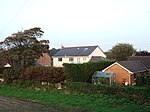Shirdley Hill railway station

Shirdley Hill was a railway station in the village of Shirdley Hill, Lancashire, on the Liverpool, Southport and Preston Junction Railway. Situated on Renacres Lane, the station opened on 1 November 1887 and was the only station on the Barton Branch to have a level crossing instead of a road bridge. The "Altcar Bob" service operated through Shirdley Hill from July 1906. The station closed to passengers on 26 September 1938, though the line remained open for goods traffic until 21 January 1952. Tracks from Butts Lane Halt to Shirdley Hill were left in place until 1964 for the storage of excursion coaches. Nothing remains of the station, with the site now occupied by a road named Shaws Garth, just off Renacres Lane. The road is named in memory of the last stationmaster, Thomas Shaw, and a plaque marks the location of the station. The plaque reads: "Site of Shirdley Hill Railway Station on the Southport-Downholland Branch Line. Closed to passengers 1938 and to goods traffic 1952. Stationmaster Thomas Shaw."
Excerpt from the Wikipedia article Shirdley Hill railway station (License: CC BY-SA 3.0, Authors, Images).Shirdley Hill railway station
Shaws Garth, West Lancashire Halsall
Geographical coordinates (GPS) Address External links Nearby Places Show on map
Geographical coordinates (GPS)
| Latitude | Longitude |
|---|---|
| N 53.6074 ° | E -2.9689 ° |
Address
Shirdley Hill
Shaws Garth
L39 8SZ West Lancashire, Halsall
England, United Kingdom
Open on Google Maps









